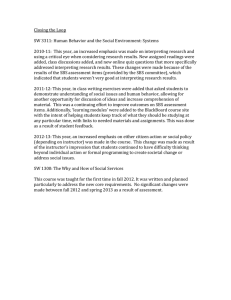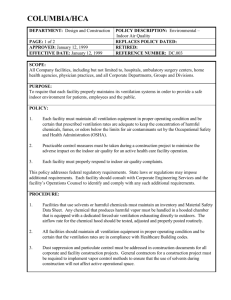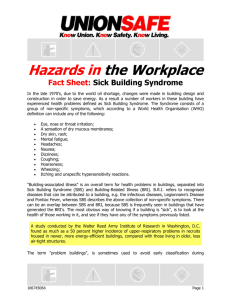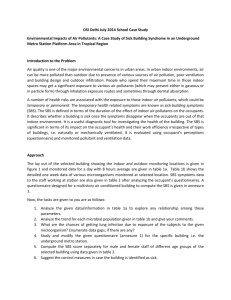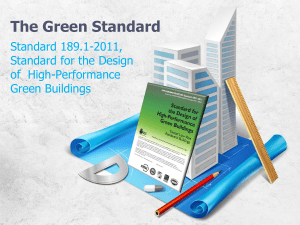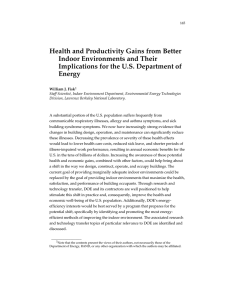Document 12032734
advertisement
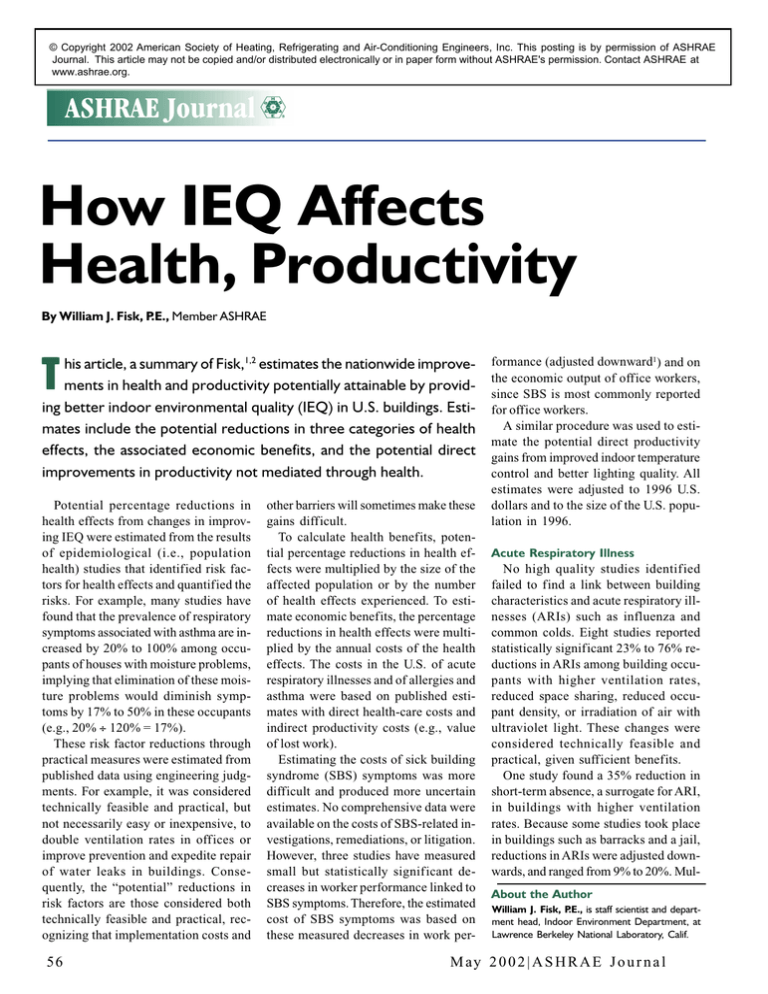
© Copyright 2002 American Society of Heating, Refrigerating and Air-Conditioning Engineers, Inc. This posting is by permission of ASHRAE Journal. This article may not be copied and/or distributed electronically or in paper form without ASHRAE's permission. Contact ASHRAE at www.ashrae.org. How IEQ Affects Health, Productivity By William J. Fisk, P.E., Member ASHRAE his article, a summary of Fisk,1,2 estimates the nationwide improvements in health and productivity potentially attainable by providing better indoor environmental quality (IEQ) in U.S. buildings. Estimates include the potential reductions in three categories of health effects, the associated economic benefits, and the potential direct improvements in productivity not mediated through health. T Potential percentage reductions in health effects from changes in improving IEQ were estimated from the results of epidemiological (i.e., population health) studies that identified risk factors for health effects and quantified the risks. For example, many studies have found that the prevalence of respiratory symptoms associated with asthma are increased by 20% to 100% among occupants of houses with moisture problems, implying that elimination of these moisture problems would diminish symptoms by 17% to 50% in these occupants (e.g., 20% ÷ 120% = 17%). These risk factor reductions through practical measures were estimated from published data using engineering judgments. For example, it was considered technically feasible and practical, but not necessarily easy or inexpensive, to double ventilation rates in offices or improve prevention and expedite repair of water leaks in buildings. Consequently, the “potential” reductions in risk factors are those considered both technically feasible and practical, recognizing that implementation costs and 56 other barriers will sometimes make these gains difficult. To calculate health benefits, potential percentage reductions in health effects were multiplied by the size of the affected population or by the number of health effects experienced. To estimate economic benefits, the percentage reductions in health effects were multiplied by the annual costs of the health effects. The costs in the U.S. of acute respiratory illnesses and of allergies and asthma were based on published estimates with direct health-care costs and indirect productivity costs (e.g., value of lost work). Estimating the costs of sick building syndrome (SBS) symptoms was more difficult and produced more uncertain estimates. No comprehensive data were available on the costs of SBS-related investigations, remediations, or litigation. However, three studies have measured small but statistically significant decreases in worker performance linked to SBS symptoms. Therefore, the estimated cost of SBS symptoms was based on these measured decreases in work per- formance (adjusted downward1) and on the economic output of office workers, since SBS is most commonly reported for office workers. A similar procedure was used to estimate the potential direct productivity gains from improved indoor temperature control and better lighting quality. All estimates were adjusted to 1996 U.S. dollars and to the size of the U.S. population in 1996. Acute Respiratory Illness No high quality studies identified failed to find a link between building characteristics and acute respiratory illnesses (ARIs) such as influenza and common colds. Eight studies reported statistically significant 23% to 76% reductions in ARIs among building occupants with higher ventilation rates, reduced space sharing, reduced occupant density, or irradiation of air with ultraviolet light. These changes were considered technically feasible and practical, given sufficient benefits. One study found a 35% reduction in short-term absence, a surrogate for ARI, in buildings with higher ventilation rates. Because some studies took place in buildings such as barracks and a jail, reductions in ARIs were adjusted downwards, and ranged from 9% to 20%. MulAbout the Author William J. Fisk, P.E., is staff scientist and department head, Indoor Environment Department, at Lawrence Berkeley National Laboratory, Calif. M ay 2 0 0 2 | A S H R A E J o u r n a l IEQ tiplying this range by annual cases of common colds and influenza resulted in an estimated 16 million to 37 million potentially avoided cases. Given the $70 billion annual cost of ARIs, potential productivity gains were $6 billion to $14 billion. toms from improved IEQ was 8% to 25%, among a large population — 53 million with allergies and 16 million asthmatics. Given the $15 billion annual cost of allergies and asthma, the potential economic gains are $1 billion to $4 billion. Sick Building Syndrome Symptoms Allergies and Asthma The scientific literature reports statistically significant links between prevalences of allergy and asthma symptoms and a variety of changeable building characteristics or practices, including indoor allergen concentrations, moisture and mold problems, pets, and tobacco smoking. The reported links between these risk factors and symptoms were often quite strong. For example, parental smoking was associated with 20% to 40% increases in asthma symptoms. In many studies, mold or moisture problems in residences were associated with 100% increases in lower respiratory symptoms indicative of asthma. These moisture and mold problems are common. For example, about 20% of U.S. houses have water leaks. Based on these data, the estimated potential reduction in allergy and asthma symp- SBS symptoms are acute symptoms, such as eye and nose irritation and headache, associated with occupancy in a specific building, but not indicating a specific disease. Risk factors for SBS symptoms identified in many studies include lower ventilation rates, presence of air conditioning, and higher indoor air temperatures. Increased chemical and microbiological pollutants in the air or on indoor surfaces, debris or moisture problems in HVAC systems, more carpets and fabrics, and less frequent vacuuming were risk factors in a small number of studies. One large study suggests that a 10 cfm (5 L/s) per person increase in ventilation rates would decrease prevalences of the most common SBS symptoms by one-third on average. Practical measures could diminish all these risk factors. Based on these data, the estimated potential reduction in SBS Advertisement in the print edition formerly in this space. 57A S H R A E J o u r n a l | M ay 2 0 0 2 M ay 2 0 0 2 | A S H R A E J o u r n a l 57 symptoms was 20% to 50%. The affected population is large — in a survey of 100 U.S. offices, 23% of office workers (64 million workers) frequently experienced two or more SBS symptoms at work. The estimated productivity reduction caused by SBS symptoms in the office worker population was 2%, with an annual cost of $60 billion. A 20% to 50% reduction in these symptoms, considered feasible and practical, would bring annual economic benefits of $10 billion to $30 billion. Direct Productivity Gains Literature documents direct linkages of worker performance with air temperatures and lighting conditions, without apparent effects on worker health. Many but not all studies indicate that small (few °C) differences in temperatures can influence workers’ speed or accuracy by 2% to 20% in tasks such as typewriting, learning performance, reading speed, multiplication speed, and word memory. Surveys have documented that indoor air temperature is often poorly controlled, implying an opportunity to increase productivity. Wyon3 estimated that providing ±3°C (±5°F) of individual temperature control would increase work performance by 3% to 7%. A smaller number of studies have documented improvements in work performance with better lighting, with benefits most apparent for visually demanding work. Increased daylighting was also linked in one study to improved student learning. Based on these studies and recognizing that performance of only some work tasks is likely to be sensitive to temperature and lighting, the estimated potential direct productivity gain is 0.5% to 5%, with the range reflecting the large uncertainty. Considering only U.S. office workers, the corresponding annual productivity gain is $20 billion to $160 billion. Benefits, Costs of Improvements Two example calculations compared estimated productivity gains with costs for increasing ventilation rates and increasing filter system efficiency. The benefit-to-cost ratios were 14 and 8, respectively. Milton, et al.4 estimated benefitto-cost ratios of three to six for the reduced absence obtained with increased ventilation, neglecting diminished health-care costs. For many other measures that increase productivity, we would expect similarly high benefit-to-cost ratios. For example, preventing or repairing roof leaks should diminish the need for costly building repairs and reduce asthma symptoms. Some measures, such as removing pets from houses of asthmatics, have negligible financial costs. Productivity Gains and Energy Efficiency In many non-industrial workplaces, the cost of workers’ salaries and benefits exceeds energy costs by approximately a factor of 100. Consequently, businesses should be strongly motivated to change building designs or operations if these 58 Potential U.S. Annual Source of Potential Annual Savings or Productivity Productivity Gain Health Benefits Gain (1996 U.S. $) 16 Million to 37 Million Avoided Reduced $6 Billion to $14 Billion Respiratory Illness Cases of Common Cold or Influenza 8% to 25% Decrease in Symptoms within Reduced Allergies 53 Million Allergy $1 Billion to $4 Billion And Asthma Sufferers and 16 Million Asthmatics 20% to 50% Reduction in SBS Health Symptoms Reduced Sick Experienced $10 Billion to $30 Billion Building Syndrome Frequently at Work Symptoms by ~15 Million Workers Improved Worker Performance from Changes in Not Applicable $20 Billion to $160 Billion Thermal Environment and Lighting Table 1: Estimated potential productivity gains. changes improved worker performance by even a significant fraction of a percent or reduced sick leave by a day or more per year. While employers may be tempted to neglect energy efficiency when seeking to improve health and productivity, the most desirable measures or packages of measures are those that improve IEQ and simultaneously save energy. Examples of such measures are provided in Fisk.1 Summary Table 1 summarizes the estimated potential health and productivity gains from improved IEQ. While uncertainty in the magnitude of potential gains is high, even the lower bounds of the estimated benefits are large from a societal perspective. Acknowledgments This work was supported by the assistant secretary for energy efficiency and renewable energy, Office of Building Technology, State, and Community Programs, Office of Building Research and Standards of the U.S. Department of Energy under contract No. DEAC03-76SF00098. References 1. Fisk, W.J. 2000. “Health and productivity gains from better indoor environments and their relationship with building energy efficiency.” Annual Review of Energy and the Environment 25(1): 537-566. 2. Fisk, W.J. 2000. “Estimates of potential nationwide productivity and health benefits from better indoor environments: An update.” Lawrence Berkeley National Laboratory Report, Chap. 4 in Indoor Air Quality Handbook eds. J.D. Spengler, J.M. Samet, J.F. McCarthy, McGraw Hill. 3. Wyon, D.P. 1996. “Indoor environmental effects on productivity.” IAQ’96 Paths to Better Building Environments pp. 5-15. ASHRAE. 4. Milton, D.K., P.M. Glencross, M.D. Walters. 2000. “Risk of sick leave associated with outdoor air supply rate, humidification, and occupant complaints.” Indoor Air 10(4): 212-221. M ay 2 0 0 2 | A S H R A E J o u r n a l
